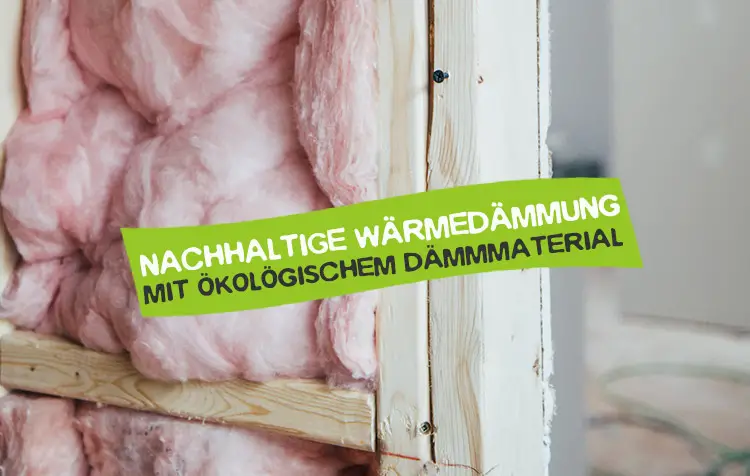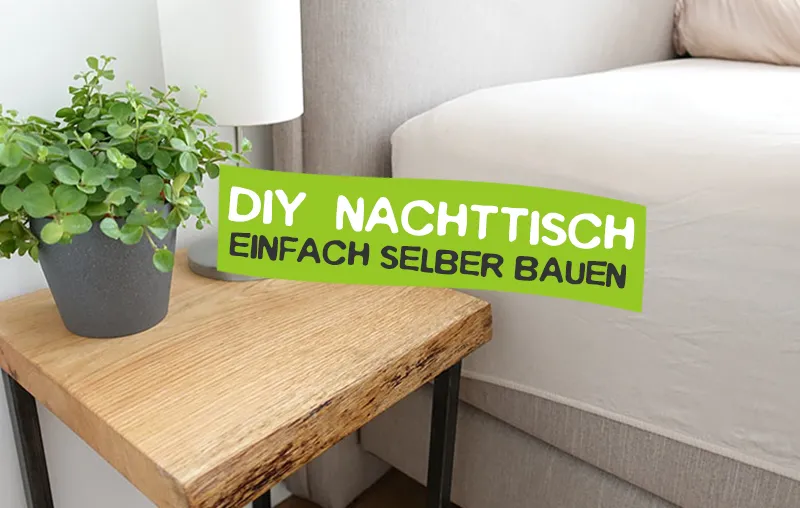You want to learn more about the most sustainable thermal insulation and ecological insulation materials? Then you've come to the right place! The sustainability of buildings is not only determined by their energy efficiency in everyday use, but also by the choice of material. Accordingly, many people are looking for green alternatives to conventional insulation materials such as foam glass, glass wool or extruded polystyrene. But can these really be replaced sustainably with similar thermal conductivity and comparable fire and sound protection properties?
In this article I would like to give you everything you need to know about sustainable thermal insulation. You'll learn why it's so important, what to look out for, and which natural insulation materials are suitable for which applications. Let's go!
In advance you can find here a short overview of the materials:
Advantages: Why is sustainable thermal insulation so important?
The main task of thermal insulation is to make interiors protect from heat and cold, through higher energy efficiency Save heating costs, maintain or even increase the value of the building - and the Increase living comfort. Through the all-encompassing, energy renovation of a building the primary energy demand can actually be reduced by up to 90 percent.₁
One thing in advance: Any reasonably effective thermal insulation material saves significantly more energy over its entire service life than has to be spent on its manufacture. As a rule, the production of any insulation material is always better for the environment than to do without insulation altogether.₂
So every insulation material is worthwhile - also from an environmental point of view! So why now an alternative as close to nature as possible to mineral and synthetic insulating materials, such as rigid polyurethane foam, vacuum insulation panels or glass wool?
The advantages of natural insulation materials
Here I present you the main advantages of sustainable insulation:
- Conserve resources: Ecological insulation materials consist of renewable raw materials or even recycled materials and therefore protect the natural resources, which the earth makes available to us.
- Grants: Some cities (e.g. Düsseldorf, Hamburg, Hanover, Münster or Munich) subsidize the use of certified natural insulation materials with special support programs from which consumers can benefit.
- More living comfort: The main advantages of insulation with natural materials also include a more comfortable indoor climate and reduced susceptibility to mold growth.
- Lower energy consumption during production: Near-natural insulating materials can be produced with a significantly lower energy input. Production is generally more climate-friendly than that of conventional alternatives.
- Easier recycling: At some point, every insulation material is replaced. Fortunately, natural insulation materials can be recycled very well or finally burned for energy generation.
Material: 11 ecological insulation materials for sustainable thermal insulation
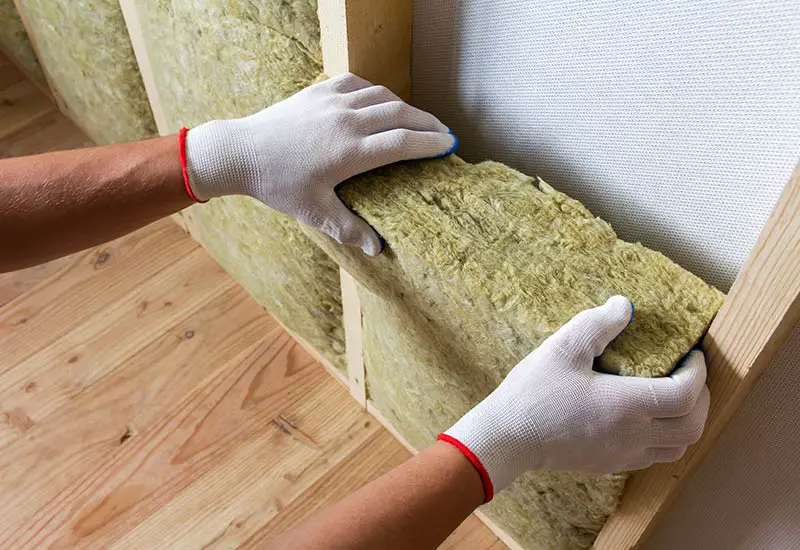
Now we can confidently move on to the ecological materials that can basically serve as insulation material. For each of them, among other things, I will give you valuable information about Heat protection, thermal insulation effect, thermal conductivity, moisture balance, fire protection and sound insulation with the hand.
You will also find out for which Application area the insulation materials are suitable₃ - because whether you have a Thermal insulation from the inside or outside, or whether you want to insulate the house roof or the basement wall, is ultimately quite decisive for the right choice of material.
1. wood fiber
The wood fiber insulation boards are placed from debarked residual wood Due to the resin, no adhesive is required for this purpose. They have a good moisture balance, are an ideal summer heat protection, protect well against sound and achieve good thermal insulation. Soft wood fibers are suitable for insulation measures on flat roofs, exterior and interior facades, chimney corners and also top floor ceilings.
Here are important facts for insulation with wood fiber boards at a glance:
- Bulk density: 110 to 600 kg/m3
- Thermal conductivity: 0.040 to 0.083 W/(mK)
- Resistance number water vapor diffusion: 3 to 5
- Fire class: B1, B2
- Temperature resistance: 110 degrees Celsius
- Cost: 16 - 45 euros per square meter
2. cork
Another sustainable alternative to conventional insulation materials is cork - either as an insulation board or loose to pour. Cork is obtained from the bark of the cork oak, offers great sound insulation and also scores well in terms of heat protection and moisture balance. Fire protection and thermal insulation are mediocre - and long transport routes are necessary.
You can use the pressure-resistant material, for example, for the Cavity insulation or use for external roof and facade insulation.
Here are important facts for insulation with cork boards at a glance:
- Bulk density: 100 to 220 kg/m3
- Thermal conductivity: 0.040 to 0.060 W/(mK)
- Resistance number water vapor diffusion: 5 to 10
- Fire class: B2
- Temperature resistance: 110 to 120 degrees Celsius
- Cost: 7 - 60 euros per square meter
3. straw
Straw can also be used to insulate walls sustainably - it is used for example in the form of straw building boards or used as a lightweight aggregate in clay products. The ecological insulating material straw can be produced with extremely low energy consumption and has a good thermal insulation effect. It also serves as heat insulation and effective soundproofing.
The material can be used mainly to insulate roofs, exterior walls and floors.
Here are important facts for insulation with straw at a glance:
- Bulk density: 85 - 115 kg/m3
- Thermal conductivity: 0.043 to 0.052 W/(mK)
- Moisture balance: moderate to good
- Fire class: B2
- Cost: about 48 euros per cubic meter
4. wood wool
Anyone interested in natural, sustainable thermal insulation should also consider wood wool. It is one of the most popular, natural insulation materials and is used made from the long-fibered chips of spruce or pine woods. It is a flame retardant insulation material that provides good protection against heat indoors and also acts as an effective sound insulator.
Since the thermal insulation effect of the material is not quite as good, wood-wool lightweight panels can be used to insulate mainly the top floor ceilings, but also interior facades and chimney ceilings.
Here are important facts for insulation with wood wool at a glance:
- Bulk density: 110 to 600 kg/m3
- Thermal conductivity: 0.040 to 0.083 W/(mK)
- Resistance number water vapor diffusion: 3 to 5
- Fire class: B1, B2
- Temperature resistance: 110 degrees Celsius
- Cost: 7 - 20 euros per square meter
5. hemp
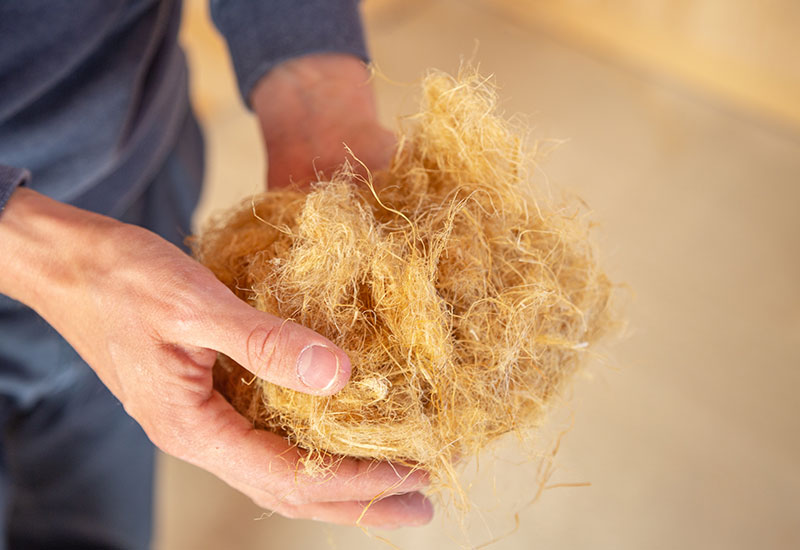
From the stems of the hemp plant an ecological insulating material with excellent thermal insulation properties can be obtained by means of a crushing and forestry process. Hemp fibers also have advantages in terms of fire protection, moisture balance and heat protection.
Possible applications include steep and flat roofs, upper floor ceilings, interior and exterior facades, but also basement ceilings.
Here are important facts for insulation with hemp at a glance:
- Bulk density: 40 to 50 kg/m3 (stuffing wool); 20 to 40 kg/m3 (mats)
- Thermal conductivity: 0.040 to 0.080 W/(mK)
- Resistance number water vapor diffusion: 1 to 2
- Fire class: B2
- Temperature resistance: 100 degrees Celsius
- Cost: 10 - 30 euros per square meter
6. meadow grass
Another and literally green insulation material, is natural meadow grass. The renewable raw material is available as blow-in and bulk insulation material and is particularly environmentally friendly due to its regional availability. The meadow grass insulation material is moisture regulating, heat insulating and also a good protection against the summer heat.
The material is particularly suitable for insulating cavities in walls, floors and roofs - and is therefore popular for renovating older existing buildings.
Here are important facts for insulation with meadow grass at a glance:
- Bulk density: 40 to 65 kg/m3
- Thermal conductivity: 0.039 and 0.046 W/(mK)
- Fire class: B2
- Cost: 52 - 107 euros per square meter
7. jute
The environmentally friendly thermal insulation also works with a fleece made of jute! To make the insulation material, you recycle old jute bags. Even though jute provides little protection against sound, it still has a great thermal insulation effect and at the same time serves as heat protection and moisture balance. The fabric is natural, free of harmful substances and cheap to have.
The jute mats and rolls are well suited for thermal insulation of the roof - for example, as between-rafter or under-rafter insulation. They can also be used to insulate flat roofs, exterior and interior facades, and the basement ceiling.
Here are important facts for insulation with jute at a glance:
- Bulk density: 30 - 50 kg/m3
- Thermal conductivity: 0.037 and 0.040 W/(mK)
- Fire class: B2
- Cost: 2.20 - 2.70 euros per square meter
8. reed
Another absolutely ecological insulation material is reed. Biodegradable reeds are pressed together to form boards. They create an ideal moisture balance and prevent rot and mold, for example. In addition, they also function well as heat and sound insulation.
In fact, buildings can be insulated with reed in many ways. For example, as on-roof insulation (the most efficient roof insulation from the outside), for floor insulation or as a thermal composite system in the walls.
Here are important facts for insulation with reed at a glance:
- Bulk density: 190 - 225 kg/m3
- Thermal conductivity: 0.038 - 0.055 W/(mK)
- Fire class: B2
- Cost: 10 - 20 euros per square meter
9. flax
Also suitable for sustainable thermal insulation is the Waste product of linen production: Flax. In mat and fleece form or also as bulk material and stuffing wool, the natural material brings an excellent thermal insulation effect. It is also very suitable as an environmentally friendly natural insulating material due to its soundproofing, moisture-balancing and heat-protecting properties.
You can use the flax insulation boards, for example, for the finishing of walls, ceilings and roofs, or even the floor. The stuffing wool from flax, on the other hand, is very suitable for sealing doors and windows.
Here are important facts for insulation with flax at a glance:
- Bulk density: 40 to 50 kg/m3 (stuffing wool); 20 to 40 kg/m3 (mats)
- Thermal conductivity: 0.040 to 0.080 W/(mK)
- Resistance number water vapor diffusion: 1 to 2
- Fire class: B2
- Temperature resistance: 100 degrees Celsius
- Cost: 5 - 50 euros per square meter
10. cellulose
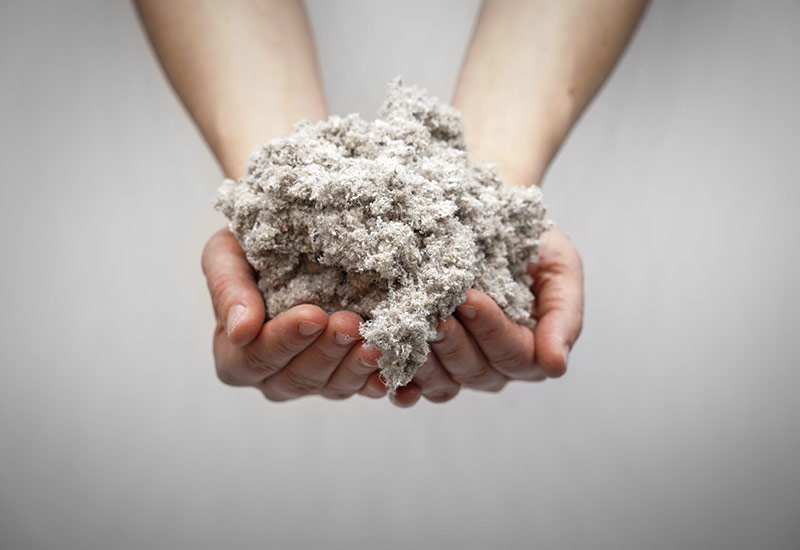
Cellulose is obtained through the recycling of waste paper. Because cellulose is biodegradable, cheap and regionally available, insulates heat very well and also protects well against heat, sound and the usual risks of moisture, it is one of the most widely used, ecological insulation materials.
You can use the insulation material, for example, to insulate roofs or partition walls. It is just as suitable as facade insulation for buildings with Timber frame construction.
Here are important facts for insulation with cellulose at a glance:
- Bulk density: 30 to 60 kg/m3
- Thermal conductivity: 0.039 to 0.045 W/(mK)
- Resistance number water vapor diffusion: 1 to 2
- Fire class: B2
- Temperature resistance: 60 degrees Celsius
- Cost: 10 - 38 euros per square meter
11. seaweed
Anyone who reads up on sustainable building insulation will inevitably hear about the slightly more modern seaweed thermal insulation. The washed up Balls from seaweed plant fibers provide excellent moisture balance and also bring a good thermal insulation effect. In addition, they serve as a good heat and sound insulation.
Seaweed is most suitable for the insulation of interior and exterior facades, an inaccessible, top floor ceiling, for the inter-rafter insulation of the roof also for the wooden beam insulation.
Here are important facts for insulation with seaweed at a glance:
- Bulk density: 65 to 75 kg/m3
- Thermal conductivity: 0.039 to 0.046 W/(mK)
- Fire class: B2
- Cost: 27 - 57 euros per square meter
Notice: There are certainly other, natural insulation materials, such as sheep's wool. For ethical reasons, however, I do not want to explain them further here. Besides the animal welfare aspect, the susceptibility to destruction by moths also speaks against sheep's wool for insulating buildings.
Sustainable thermal insulation pays off!
And not only for your wallet and your well-being, but also for the environment. By investing in one of the above-mentioned ecological insulating materials, you not only help to increase the energy efficiency of buildings in Germany - you also save energy during production, Conserves natural resources and facilitate recycling.
However you use the knowledge from this post: I hope that with the information I've provided, I've been able to help you achieve more environmentally friendly insulation.
Do you have any questions, tips or your own experiences with energy-efficient, sustainable thermal insulation that you would like to share? Then I look forward to your comment.
Stay sustainable,

PS.: Do you already know how to basically. build sustainably can? In the linked article you will now learn the most important tips for this!
References:
₁,₂ Federal Environment Agency: Thermal Insulation Questions and Answers (as of March 2016), available at https://www.umweltbundesamt.de/sites/default/files/medien/376/publikationen/waermedaemmung_fragen_und_antworten_web.pdf. [14.12.2022].
₃ N. Paul (2015), Ecological Insulation Materials, available at https://benz24.de/media/landingpages/ratgeber/ebook/oekologisch_daemmen/leitfaden-ratgeber-oekologische-daemmstoffe.pdf. [14.12.2022].

